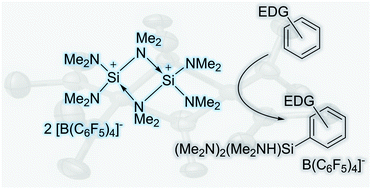Tris(dimethylamino)silylium ion: structure and reactivity of a dimeric silaguanidinium†
Abstract
Although several strategies for the stabilization of silylium ions have been established, “π-stabilization” with directly attached π-donor heteroatoms at silicon has not been developed yet. Hydride abstraction from (Me2N)3SiH generates dicationic [(Me2N)3Si+]2 in solution and in the solid state – constituting the dimer of an elusive silaguanidinium ion. This compound can be synthesized on a gram scale and is compatible with common organic solvents. However, it readily undergoes spontaneous electrophilic silylation of electron-rich aromatic compounds or initiates a catalytic hydro-defluorination reaction.

- This article is part of the themed collection: Editor’s Choice: Main group reagents and catalysts in organic reactions


 Please wait while we load your content...
Please wait while we load your content...